Architecture of Belfast
The architecture of Belfast comprises architectural styles ranging from Georgian through to modernist buildings such as the Waterfront Hall and Titanic Belfast. The city's Victorian and Edwardian buildings are notable for their display of a large number of sculptures. Many of Belfast's Victorian era landmarks, including the main Lanyon Building at Queens University, were designed by Sir Charles Lanyon.
Chronology and styles
Belfast became a substantial settlement in the 17th century, after being established as a town by Sir Arthur Chichester.[1] None of the buildings from Belfast’s first century as a market town on the river Farset survive today. The only significant structures in those early years from 1613 would have been a castle established by Sir Arthur Chichester, and the parish church at the foot of High Street, where a ‘chapel of the ford’ had been erected by 1306, and where St George’s church now stands.
Georgian
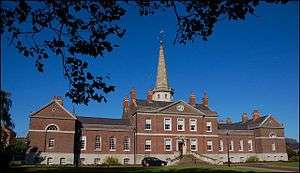 Clifton House
Clifton House
(1771–1774; Grade A) The Exchange and Assembly Rooms
The Exchange and Assembly Rooms
(1769)
Remodelled in 1845
Victorian
 Botanic Gardens Palm House
Botanic Gardens Palm House
(1839–1840) Lanyon Building
Lanyon Building
(1849) 16 Victoria Street
16 Victoria Street
(1852; Grade B) Union Theological College
Union Theological College
(1853; Grade A)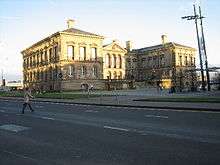 The Custom House
The Custom House
(1856)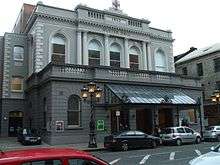
- The Headline Building
(1863)  Clarence House
Clarence House
(1867) Belfast Castle
Belfast Castle
(1811–1870; Grade B+)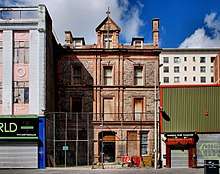
 The Old Town Hall
The Old Town Hall
(1860–1879; Grade B1)
 The Scottish Provident Institution
The Scottish Provident Institution
(1899–1902; Grade A)
20th century
Edwardian
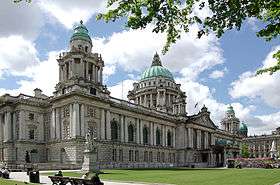 Belfast City Hall
Belfast City Hall
(1898–1906; Grade A)
Pre-World War II and Art Deco
- Ulster Museum
(1929; extended 1962; Grade B1) 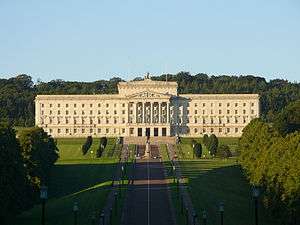 Parliament Buildings
Parliament Buildings
(1922–1932; Grade A)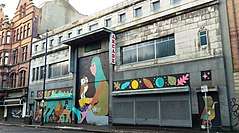 North Street Arcade
North Street Arcade
(1936–1938; Grade B1) Telephone House
Telephone House
(1920–1939; Grade B2) Broadcasting House
Broadcasting House
(1938–1941; Grade B1)
Late 20th century
- Windsor House
(1975)  Belfast City Hospital Tower
Belfast City Hospital Tower
(1986) Waterfront Hall
Waterfront Hall
(1995–1997) BT Riverside Tower
BT Riverside Tower
(1998)_-_geograph.org.uk_-_1249088.jpg) Belfast Hilton
Belfast Hilton
(1998)
21st century
In 2011 and 2012 Belfast saw the creation of two buildings described as "two of the most stunning new British buildings of the century",[2] namely the Lyric Theatre (2011) by Irish architects O’Donnell and Tuomey, and the Metropolitan Arts Centre (2012) by local architectural practice Hackett Hall McKnight. In contrast, the new boat-shaped Titanic Museum (2012) was described by The Telegraph as "startlingly inane".[2]
 Obel Tower (2006–2011)
Obel Tower (2006–2011)_-_geograph.org.uk_-_716074.jpg) Victoria Square (2008)
Victoria Square (2008)- The Boat (2010)
 Titanic Belfast (2012)
Titanic Belfast (2012)- The MAC (2012)
_-_geograph.org.uk_-_1716262.jpg) Lanyon Plaza (2014)
Lanyon Plaza (2014)
See also
References
Notes
- "History of Belfast Castle". Tourism and venues. Belfast City Council. 2014. Archived from the original on 19 May 2014. Retrieved 19 May 2014.
- "Belfast: rising from the ruin of the Troubles". The Telegraph. 25 April 2012. Retrieved 27 October 2014.